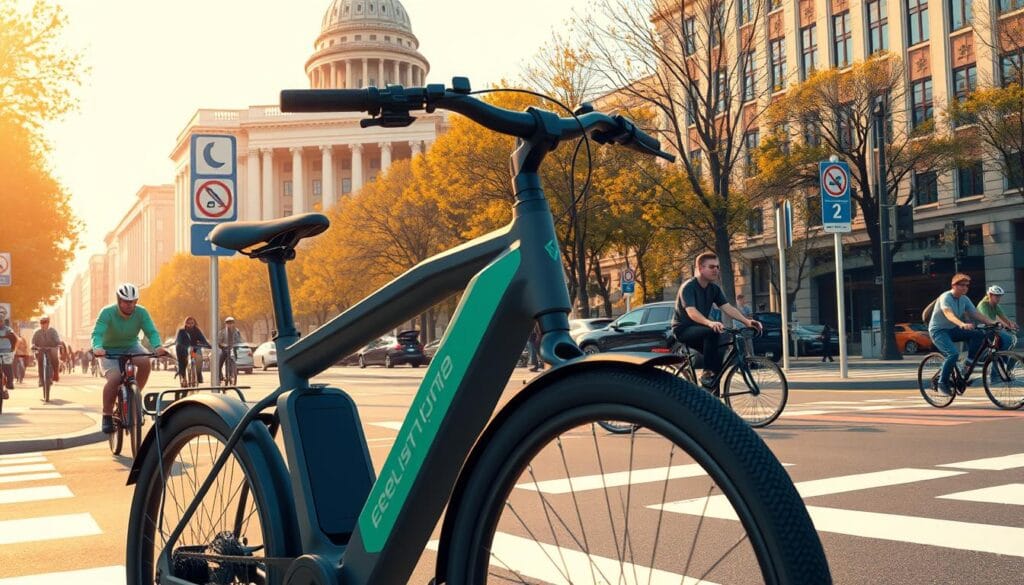Electric Bike Laws 2025: What Riders Need to Know
The wind rushes past your face as you pedal down the street, your electric bike humming with quiet power. But wait – are you aware of the sweeping changes coming to electric bike regulations in 2025? The landscape of ebike regulations is transforming, and staying informed about these legal requirements for ebikes has never been more critical.
In 2022, the United States saw a remarkable 1.1 million e-bikes sold, signaling a transportation revolution. The Electric Bike Laws 2025 are set to reshape how we understand and use these innovative vehicles, introducing comprehensive safety measures and clear operational guidelines.
Navigating these new ebike regulations requires understanding, preparation, and a commitment to responsible riding. Whether you’re a seasoned e-bike enthusiast or a curious newcomer, knowing the upcoming legal requirements for ebikes will keep you safe, compliant, and enjoying your ride.
Table of Contents
Overview of Electric Bike Laws in 2025
Electric bikes have changed how we move around cities. They need clear rules to stay safe and keep up with new tech. Knowing the laws helps riders stay safe in a world of powered bicycles.
What Are Electric Bikes?
An electric bike, or e-bike, has an electric motor to help you pedal or move without pedaling. In California, e-bikes must have pedals and a motor that’s not too powerful.
Why Are Laws Necessary?
Laws for e-bikes keep everyone safe. They make sure e-bikes are used right. With more e-bikes around, laws help keep things safe and fair.
Key Objectives of Electric Bike Regulations
- Establish clear e-bike classifications
- Ensure rider and pedestrian safety
- Define technical specifications
- Standardize battery and motor requirements
| E-Bike Class | Max Speed | Motor Type |
|---|---|---|
| Class 1 | 20 mph | Pedal-assist only |
| Class 2 | 20 mph | Throttle-assisted |
| Class 3 | 28 mph | Pedal-assist |
Starting January 1, 2026, California will have new rules for e-bike batteries. These rules are set by the State Fire Marshal. They make sure electric bicycle legislation keeps people safe and tech reliable.
Types of Electric Bikes Defined
It’s important to know the different types of electric bikes. This knowledge helps you follow new ebike laws and guidelines. The 2025 rules have set up three main types of electric bikes. Each type has its own rules and limits.
Class 1: Pedal-Assist Only E-Bikes
Class 1 electric bikes are the simplest to use. They help you pedal only when you’re pedaling. They have a few key features:
- Maximum assisted speed of 20 mph
- Motor kicks in only when you pedal
- Great for those who want a little electric help
Class 2: Throttle-Assist E-Bikes
Class 2 electric bikes offer more freedom. They have special features that follow ebike guidelines:
- Top speed of 20 mph
- You can move without pedaling
- Perfect for city rides and fun trips
Class 3: High-Performance Speed E-Bikes
Class 3 electric bikes are the fastest. They have strict rules and high performance:
- Pedal-assist up to 28 mph
- No throttle allowed
- Best for experienced riders
“Knowing your e-bike’s classification is key to staying compliant with local regulations.” – E-Bike Safety Association
Each type of electric bike has its own benefits and rules. Knowing this helps you pick the right bike. It also makes sure you follow local ebike laws.
State-by-State Variation in Electric Bike Regulations
Understanding Electric Bike Laws 2025 can be tough because of big differences in each state. It’s key for riders to know these rules to stay safe and follow the law.
What’s legal for ebikes varies a lot from state to state. Here are some important points:
- 44 states and Washington, D.C. have their own rules for electric bikes
- 26 states follow the “3-Class” system for eBikes
- How a state classifies ebikes can change where and how you can ride
Regional Regulatory Differences
Some states have their own ways of handling electric bike rules. For instance:
- Hawaii makes you register your electric bike for $30
- Alaska sees some electric bikes as cars
- Rhode Island follows the federal rules for ebikes
Resources for Checking State Laws
To keep up with your local ebike laws, use these trusted sources:
- State Department of Motor Vehicles websites
- Local bicycle groups
- National bike safety groups
“Knowing your local electric bike laws is your first safety step and way to follow the rules.”
Remember, laws can change fast. Always check the latest Electric Bike Laws 2025 in your state. This way, you can ride legally and safely.
Age Restrictions for Electric Bike Riders
Knowing about e-bike rules in 2025 is key. It’s important to understand age limits and safety rules. Electric bike laws vary by state, so knowing your local rules is crucial.
The age you can ride an electric bike depends on the bike’s class and your state’s laws. Each e-bike class has its own age limit to keep riders safe.
Minimum Age Requirements by E-Bike Class
- Class 1 E-Bikes: Generally no minimum age restriction
- Class 2 E-Bikes: Typically allows riders of most ages
- Class 3 E-Bikes: Minimum age requirement of 16 in most states
State-Specific Age Restrictions
| State | Minimum Age | E-Bike Class |
|---|---|---|
| California | 16 | Class 3 |
| New York | 14 | All Classes |
| Florida | 16 | All Classes |
| Texas | No Restriction | All Classes |
Parental Supervision Guidelines
Parents need to watch over young riders. They should make sure kids know the laws about electric bikes. It’s important for kids to wear helmets, follow traffic rules, and use safety gear.
Safety comes first: Always prioritize proper training and protective equipment for young riders.
Remember, local laws can change. Always check your state’s e-bike policies in 2025 to stay safe and follow the rules.
Licensing and Registration Requirements
Understanding the rules for powered bicycles can be tricky. The rules for electric bikes vary a lot from state to state. It’s important to know the government guidelines for ebikes before you ride.
Most states treat electric bikes like regular bikes. Knowing these rules helps you ride safely and legally.
License Requirements by E-Bike Class
Electric bike licensing depends on the bike’s class:
- Class 1 E-Bikes: Typically no license required
- Class 2 E-Bikes: Generally exempt from licensing
- Class 3 E-Bikes: May require additional documentation in some states
State-Specific Registration Details
While most states don’t need registration, a few have special rules:
- Hawaii requires a $30 registration fee
- Rhode Island mandates registration for e-bikes exceeding 25 mph
- Alaska classifies e-bikes as “motor-driven cycles”
“Know your local laws before you ride” – E-Bike Safety Association
Only 11 states require a special license for electric bikes. Most states use a three-class system to make rules easier for riders.
Age and Licensing Considerations
Age rules are important for e-bike licensing:
- Many places let riders 14-16 years old use Class 1 and 2 e-bikes
- Class 3 e-bikes often have stricter age rules (16 years or older)
- Some states like New York let riders 16 and above ride without extra licensing
Always check your local laws, as ebike rules can change fast. Being informed ensures a safe and legal ride.
Equipment and Safety Regulations
Electric Bike Laws 2025 bring new safety rules to keep riders safe. It’s key for all electric bike fans to know these rules.

Helmet Requirements
Wearing a helmet is the first step in safety. Now, electric bikes have strict helmet rules based on their type:
- Class 3 e-bikes: Mandatory helmet for all riders
- Class 1 and 2 e-bikes: Recommended for riders under 18
- Helmets must meet current safety certification standards
Lighting and Visibility for Night Riding
Being seen is vital for safety at night. New rules require certain lights on electric bikes:
- White front light visible from 300 feet
- Red rear reflector or light
- Reflective clothing recommended for low-light conditions
Battery and Charging Safety
Starting January 1, 2026, e-bike makers must follow strict battery rules:
- Batteries must be tested by accredited laboratories
- Certification labels required on all e-bike batteries
- Charging systems must be certified for specific bike models
Remember, your safety is paramount. Always follow the latest electric bike laws and regulations to protect yourself and others on the road.
Where You Can Ride Electric Bikes
Knowing the legal rules for ebikes is key for safe riding in 2025. E-bike laws are changing, with rules on where you can ride. Local laws are important for where you can go on your electric bike.
Public Roads and Bike Path Regulations
Different ebike classes have different rules for public roads and bike paths. Here’s a quick guide on where you can ride:
- Class 1 e-bikes are usually okay on most bike paths and trails
- Class 2 e-bikes might not be allowed on all bike paths
- Class 3 e-bikes often face stricter rules on shared paths
Local Ordinance Considerations
Your local area can greatly affect where you can ride. Cities and counties have their own e-bike rules. It’s vital to check your local laws before you ride.
| E-Bike Class | Public Road Access | Bike Path Access |
|---|---|---|
| Class 1 | Fully Permitted | Typically Allowed |
| Class 2 | Fully Permitted | Partially Restricted |
| Class 3 | Fully Permitted | Often Limited |
Pro tip: Always wear a helmet and follow local traffic laws, no matter your e-bike class. Some places might need extra safety gear or have special rules for when you can ride.
Insurance and Liability Considerations
As electric bike usage grows, knowing about insurance and liability is key. With 1.1 million e-bikes sold in 2022 and more injuries, it’s vital to protect your finances.
Understanding the rules for powered bicycles is important. Insurance is not always required but can be a big help for riders.
Do You Need Insurance for Your E-Bike?
Most insurance doesn’t cover e-bike risks well. Think about these points when deciding on insurance:
- E-bike value (ranging from $500 to $3,000)
- How often you ride
- The area you ride in
- How much risk you’re willing to take
Understanding Your Liability as a Rider
New laws focus on rider responsibility. Special e-bike insurance can help with unique challenges:
| Coverage Type | Typical Cost | Protection Scope |
|---|---|---|
| Theft Protection | $100-$200/year | Covers e-bike replacement |
| Liability Coverage | $200-$300/year | Protects against accident claims |
| Comprehensive | $250-$350/year | Full damage and liability protection |
It’s smart to know about your financial risks. Choosing the right coverage can save you thousands in damages.
About 60% of e-bike owners don’t have special insurance. It’s crucial to protect your investment and avoid big financial risks.
The Impact of Federal Legislation on Electric Bikes
Federal laws are changing how electric bikes are regulated in the U.S. These laws now cover safety, how bikes are classified, and new technologies.

The Electric Bike Laws 2025 are changing how e-bikes are seen and controlled nationwide. Important updates are coming that will affect riders and makers a lot.
Recent Federal Legislative Changes
The federal government has made big steps in setting rules for ebikes. Some key changes include:
- Defining low-speed electric bicycles under the Consumer Product Act
- Creating a three-tier classification system
- Proposing tax credits for buying e-bikes
Classification and Power Specifications
Now, federal rules set clear limits for low-speed electric bicycles:
| Specification | Limit |
|---|---|
| Maximum Motor Power | 750 watts (1.01 horsepower) |
| Maximum Speed | 20 miles per hour |
Future Legislative Trends
Future ebike rules will likely focus on:
- Battery safety standards
- Rider training needs
- Green initiatives
Expect more safety rules and tax breaks as the government backs e-bike use more.
Environmental Benefits of Electric Bikes
Electric bikes are changing how we move around cities. New laws in 2025 aim to make them a key part of green transport. This helps cut down on harmful carbon emissions.
Electric bikes are good for the planet. They are much cleaner than cars:
- Cycling produces only 21 grams of CO2 per passenger kilometer
- Cars generate approximately 271 grams of CO2 per passenger kilometer
- Electric bikes can potentially reduce car CO2 emissions by 24.4 million tonnes annually in England
Emission Reduction Strategies
New rules are pushing for greener travel. Electric bike motors use more energy efficiently than old car engines.
| Transportation Method | CO2 Emissions | Energy Efficiency |
|---|---|---|
| Traditional Car | 271g/passenger km | Low |
| Electric Bike | 21g/passenger km | High |
Urban Mobility Solutions
2025 e-bike laws see electric bikes as key to green cities. Cities are starting programs to help people use e-bikes more. This includes money help and better bike paths.
Choosing an electric bike means you’re part of a big change. It’s a step towards cleaner, better city travel for everyone.
Tips for Staying Compliant with Electric Bike Laws
Understanding ebike laws can be tough. Knowing the rules for electric bikes is key for safe riding in 2025.
Keeping Updated with Local Changes
It’s important to know about local e-bike laws. States have different rules that can change fast.
- Check your local transportation department website monthly
- Subscribe to e-bike community newsletters
- Follow local cycling advocacy groups on social media
- Attend city council meetings about transportation regulations
Best Practices for Safe Riding
Following e-bike laws is more than just knowing them. Riders must also practice safety and understand their duties.
- Always wear a DOT-approved helmet
- Ensure your e-bike meets federal motor power standards (750 watts maximum)
- Install required safety equipment like lights and reflectors
- Respect speed limits and local riding restrictions
By staying informed and following local rules, you can enjoy your e-bike safely and legally.
Remember: Laws protect both riders and pedestrians. Compliance is not just about avoiding penalties, but ensuring everyone’s safety.
Resources for Electric Bike Riders
Understanding the new ebike laws can be tough. But, many groups and online forums are here to help. Sites like PeopleForBikes and the Electric Bike Association have guides on ebike laws. They make sure you know the rules for 2025 and more.
Groups like the Bicycle Product Suppliers Association have lots of resources for e-bike fans. Their websites have the latest on rules, safety tips, and what you need to know for different e-bike types. You can watch webinars, download guides, and join forums to keep up with changing rules.
Reddit’s e-bike communities and sites like ElectricBikeReview.com offer support from other riders. You can ask questions, get tips on local rules, and share your own experiences. These places are great for learning from others who know the ebike scene well.
To get the latest news, bookmark government transportation sites and follow local cycling groups on social media. Being informed and proactive lets you ride safely and with confidence under the new rules.







